Developing Workplace Critical Thinking: A Tesco Analysis Report
VerifiedAdded on 2023/01/11
|16
|4832
|22
Report
AI Summary
This report examines the significance of critical thinking in the workplace, using Tesco as a case study. It delves into the interplay of beliefs, attitudes, and values within an organizational context, exploring their impact on individual and collective behavior. The report identifies and analyzes a relevant management theory, such as the Expectancy Value Model, assessing its influence on personal beliefs and workplace conduct. It emphasizes the importance of self-reflection and critical assessment in understanding how personal values and attitudes shape professional interactions and decision-making. The analysis covers organizational structures, communication, and the need for a harmonious environment that encourages diverse perspectives. The report also explores the role of management in fostering critical thinking skills and creating an environment where individuals can contribute their best efforts to achieve organizational goals. The study emphasizes the importance of continuous research and development in understanding and improving workplace behavior.
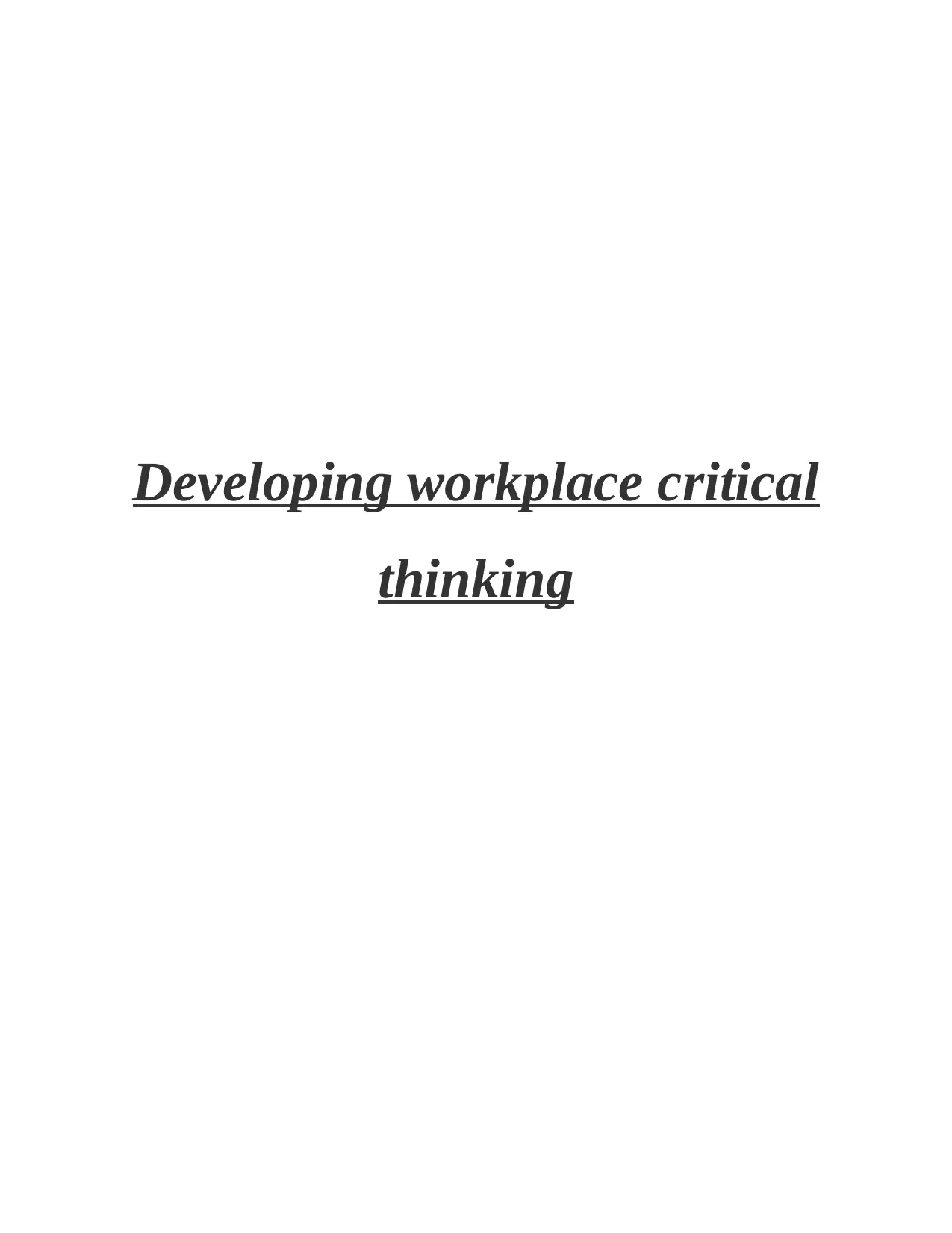
Developing workplace critical
thinking
thinking
Paraphrase This Document
Need a fresh take? Get an instant paraphrase of this document with our AI Paraphraser
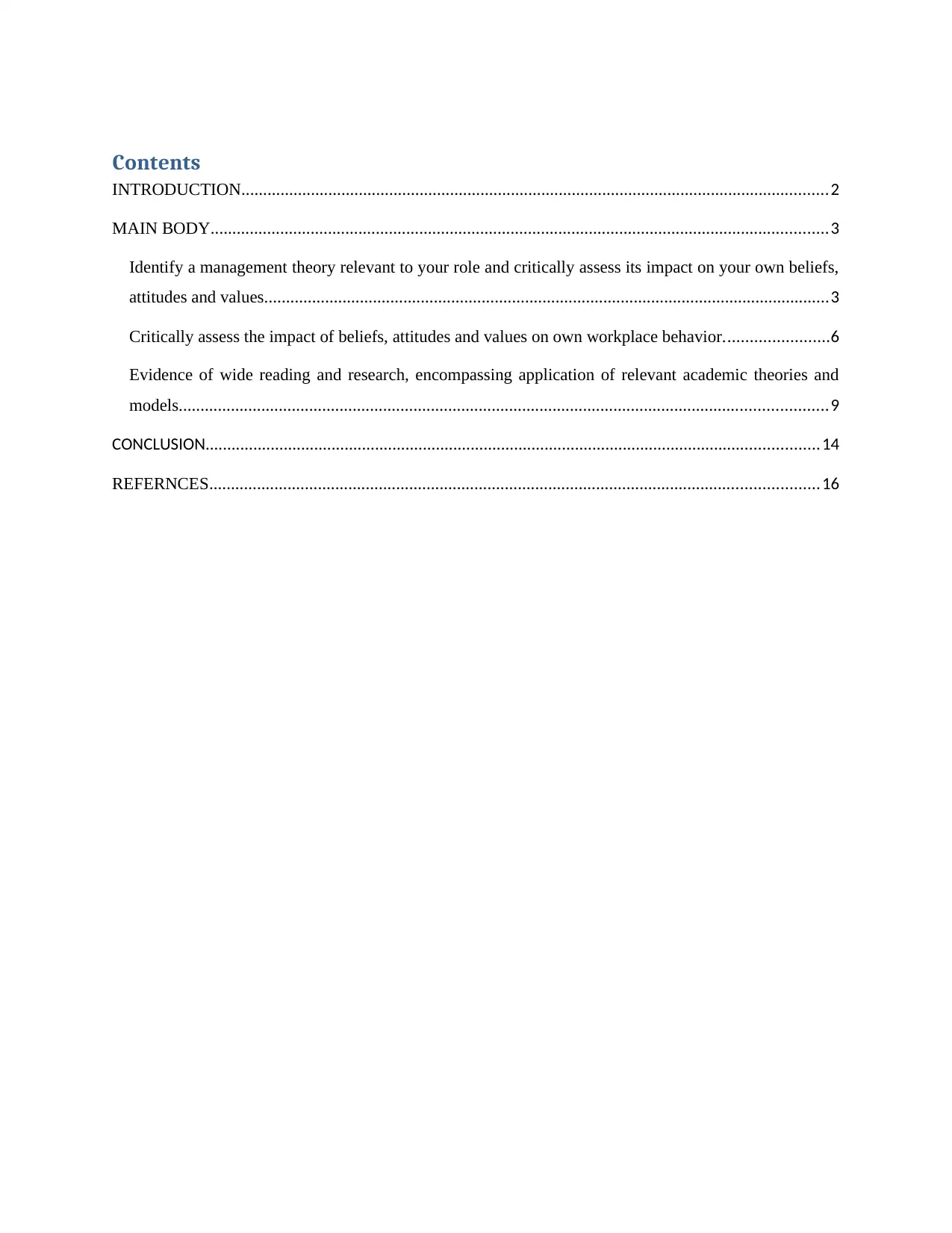
Contents
INTRODUCTION.......................................................................................................................................2
MAIN BODY..............................................................................................................................................3
Identify a management theory relevant to your role and critically assess its impact on your own beliefs,
attitudes and values..................................................................................................................................3
Critically assess the impact of beliefs, attitudes and values on own workplace behavior........................6
Evidence of wide reading and research, encompassing application of relevant academic theories and
models.....................................................................................................................................................9
CONCLUSION.............................................................................................................................................14
REFERNCES............................................................................................................................................16
INTRODUCTION.......................................................................................................................................2
MAIN BODY..............................................................................................................................................3
Identify a management theory relevant to your role and critically assess its impact on your own beliefs,
attitudes and values..................................................................................................................................3
Critically assess the impact of beliefs, attitudes and values on own workplace behavior........................6
Evidence of wide reading and research, encompassing application of relevant academic theories and
models.....................................................................................................................................................9
CONCLUSION.............................................................................................................................................14
REFERNCES............................................................................................................................................16
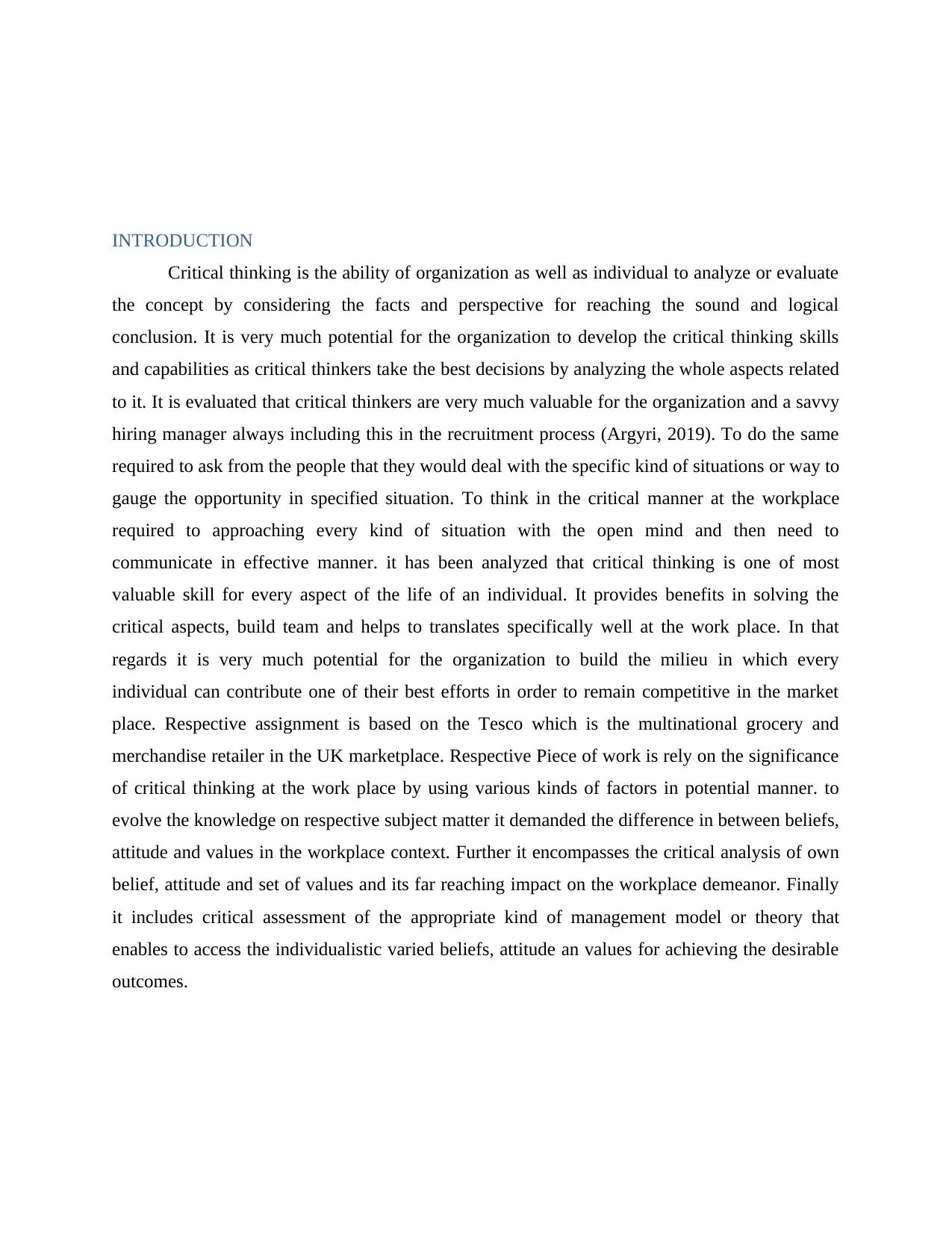
INTRODUCTION
Critical thinking is the ability of organization as well as individual to analyze or evaluate
the concept by considering the facts and perspective for reaching the sound and logical
conclusion. It is very much potential for the organization to develop the critical thinking skills
and capabilities as critical thinkers take the best decisions by analyzing the whole aspects related
to it. It is evaluated that critical thinkers are very much valuable for the organization and a savvy
hiring manager always including this in the recruitment process (Argyri, 2019). To do the same
required to ask from the people that they would deal with the specific kind of situations or way to
gauge the opportunity in specified situation. To think in the critical manner at the workplace
required to approaching every kind of situation with the open mind and then need to
communicate in effective manner. it has been analyzed that critical thinking is one of most
valuable skill for every aspect of the life of an individual. It provides benefits in solving the
critical aspects, build team and helps to translates specifically well at the work place. In that
regards it is very much potential for the organization to build the milieu in which every
individual can contribute one of their best efforts in order to remain competitive in the market
place. Respective assignment is based on the Tesco which is the multinational grocery and
merchandise retailer in the UK marketplace. Respective Piece of work is rely on the significance
of critical thinking at the work place by using various kinds of factors in potential manner. to
evolve the knowledge on respective subject matter it demanded the difference in between beliefs,
attitude and values in the workplace context. Further it encompasses the critical analysis of own
belief, attitude and set of values and its far reaching impact on the workplace demeanor. Finally
it includes critical assessment of the appropriate kind of management model or theory that
enables to access the individualistic varied beliefs, attitude an values for achieving the desirable
outcomes.
Critical thinking is the ability of organization as well as individual to analyze or evaluate
the concept by considering the facts and perspective for reaching the sound and logical
conclusion. It is very much potential for the organization to develop the critical thinking skills
and capabilities as critical thinkers take the best decisions by analyzing the whole aspects related
to it. It is evaluated that critical thinkers are very much valuable for the organization and a savvy
hiring manager always including this in the recruitment process (Argyri, 2019). To do the same
required to ask from the people that they would deal with the specific kind of situations or way to
gauge the opportunity in specified situation. To think in the critical manner at the workplace
required to approaching every kind of situation with the open mind and then need to
communicate in effective manner. it has been analyzed that critical thinking is one of most
valuable skill for every aspect of the life of an individual. It provides benefits in solving the
critical aspects, build team and helps to translates specifically well at the work place. In that
regards it is very much potential for the organization to build the milieu in which every
individual can contribute one of their best efforts in order to remain competitive in the market
place. Respective assignment is based on the Tesco which is the multinational grocery and
merchandise retailer in the UK marketplace. Respective Piece of work is rely on the significance
of critical thinking at the work place by using various kinds of factors in potential manner. to
evolve the knowledge on respective subject matter it demanded the difference in between beliefs,
attitude and values in the workplace context. Further it encompasses the critical analysis of own
belief, attitude and set of values and its far reaching impact on the workplace demeanor. Finally
it includes critical assessment of the appropriate kind of management model or theory that
enables to access the individualistic varied beliefs, attitude an values for achieving the desirable
outcomes.
⊘ This is a preview!⊘
Do you want full access?
Subscribe today to unlock all pages.

Trusted by 1+ million students worldwide
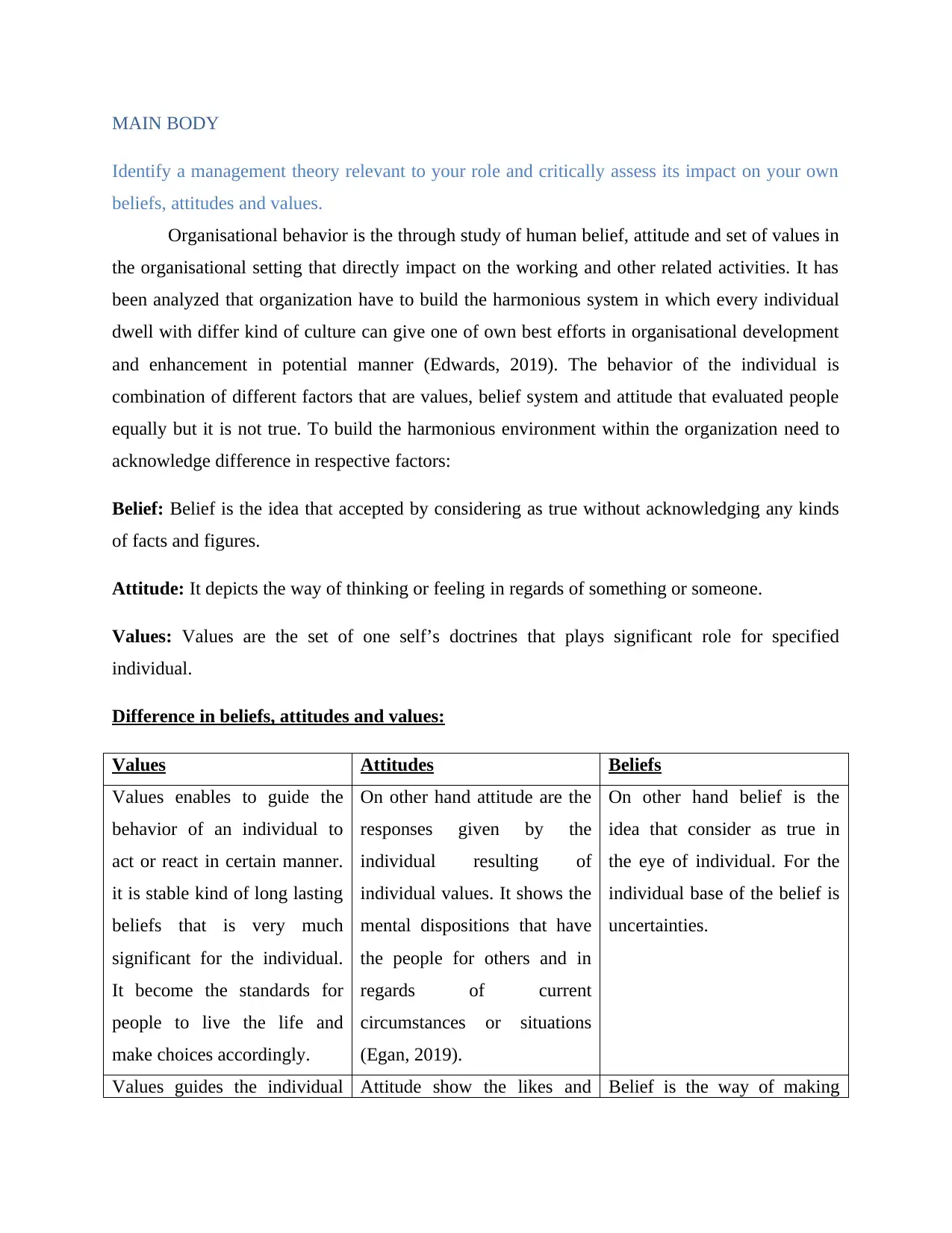
MAIN BODY
Identify a management theory relevant to your role and critically assess its impact on your own
beliefs, attitudes and values.
Organisational behavior is the through study of human belief, attitude and set of values in
the organisational setting that directly impact on the working and other related activities. It has
been analyzed that organization have to build the harmonious system in which every individual
dwell with differ kind of culture can give one of own best efforts in organisational development
and enhancement in potential manner (Edwards, 2019). The behavior of the individual is
combination of different factors that are values, belief system and attitude that evaluated people
equally but it is not true. To build the harmonious environment within the organization need to
acknowledge difference in respective factors:
Belief: Belief is the idea that accepted by considering as true without acknowledging any kinds
of facts and figures.
Attitude: It depicts the way of thinking or feeling in regards of something or someone.
Values: Values are the set of one self’s doctrines that plays significant role for specified
individual.
Difference in beliefs, attitudes and values:
Values Attitudes Beliefs
Values enables to guide the
behavior of an individual to
act or react in certain manner.
it is stable kind of long lasting
beliefs that is very much
significant for the individual.
It become the standards for
people to live the life and
make choices accordingly.
On other hand attitude are the
responses given by the
individual resulting of
individual values. It shows the
mental dispositions that have
the people for others and in
regards of current
circumstances or situations
(Egan, 2019).
On other hand belief is the
idea that consider as true in
the eye of individual. For the
individual base of the belief is
uncertainties.
Values guides the individual Attitude show the likes and Belief is the way of making
Identify a management theory relevant to your role and critically assess its impact on your own
beliefs, attitudes and values.
Organisational behavior is the through study of human belief, attitude and set of values in
the organisational setting that directly impact on the working and other related activities. It has
been analyzed that organization have to build the harmonious system in which every individual
dwell with differ kind of culture can give one of own best efforts in organisational development
and enhancement in potential manner (Edwards, 2019). The behavior of the individual is
combination of different factors that are values, belief system and attitude that evaluated people
equally but it is not true. To build the harmonious environment within the organization need to
acknowledge difference in respective factors:
Belief: Belief is the idea that accepted by considering as true without acknowledging any kinds
of facts and figures.
Attitude: It depicts the way of thinking or feeling in regards of something or someone.
Values: Values are the set of one self’s doctrines that plays significant role for specified
individual.
Difference in beliefs, attitudes and values:
Values Attitudes Beliefs
Values enables to guide the
behavior of an individual to
act or react in certain manner.
it is stable kind of long lasting
beliefs that is very much
significant for the individual.
It become the standards for
people to live the life and
make choices accordingly.
On other hand attitude are the
responses given by the
individual resulting of
individual values. It shows the
mental dispositions that have
the people for others and in
regards of current
circumstances or situations
(Egan, 2019).
On other hand belief is the
idea that consider as true in
the eye of individual. For the
individual base of the belief is
uncertainties.
Values guides the individual Attitude show the likes and Belief is the way of making
Paraphrase This Document
Need a fresh take? Get an instant paraphrase of this document with our AI Paraphraser
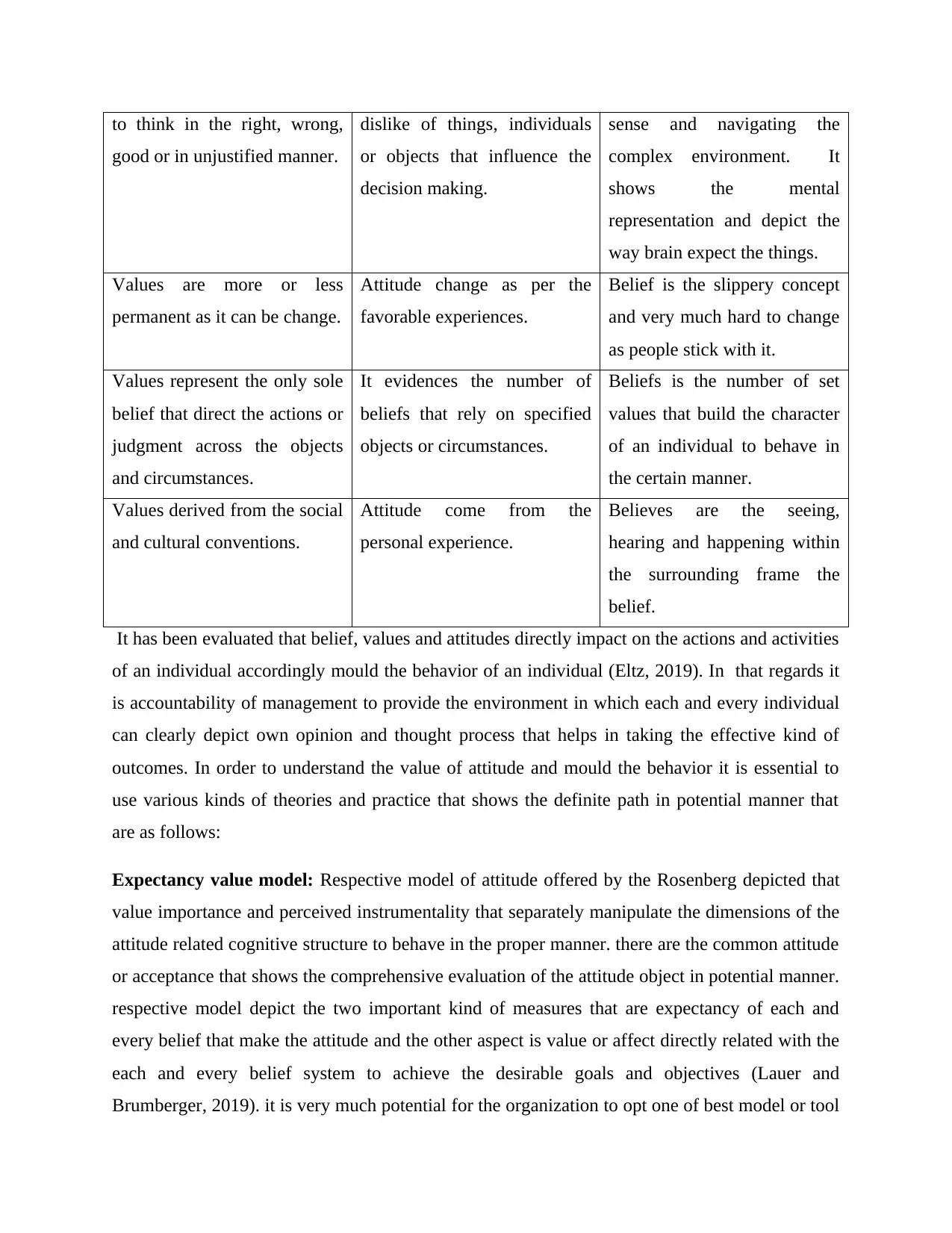
to think in the right, wrong,
good or in unjustified manner.
dislike of things, individuals
or objects that influence the
decision making.
sense and navigating the
complex environment. It
shows the mental
representation and depict the
way brain expect the things.
Values are more or less
permanent as it can be change.
Attitude change as per the
favorable experiences.
Belief is the slippery concept
and very much hard to change
as people stick with it.
Values represent the only sole
belief that direct the actions or
judgment across the objects
and circumstances.
It evidences the number of
beliefs that rely on specified
objects or circumstances.
Beliefs is the number of set
values that build the character
of an individual to behave in
the certain manner.
Values derived from the social
and cultural conventions.
Attitude come from the
personal experience.
Believes are the seeing,
hearing and happening within
the surrounding frame the
belief.
It has been evaluated that belief, values and attitudes directly impact on the actions and activities
of an individual accordingly mould the behavior of an individual (Eltz, 2019). In that regards it
is accountability of management to provide the environment in which each and every individual
can clearly depict own opinion and thought process that helps in taking the effective kind of
outcomes. In order to understand the value of attitude and mould the behavior it is essential to
use various kinds of theories and practice that shows the definite path in potential manner that
are as follows:
Expectancy value model: Respective model of attitude offered by the Rosenberg depicted that
value importance and perceived instrumentality that separately manipulate the dimensions of the
attitude related cognitive structure to behave in the proper manner. there are the common attitude
or acceptance that shows the comprehensive evaluation of the attitude object in potential manner.
respective model depict the two important kind of measures that are expectancy of each and
every belief that make the attitude and the other aspect is value or affect directly related with the
each and every belief system to achieve the desirable goals and objectives (Lauer and
Brumberger, 2019). it is very much potential for the organization to opt one of best model or tool
good or in unjustified manner.
dislike of things, individuals
or objects that influence the
decision making.
sense and navigating the
complex environment. It
shows the mental
representation and depict the
way brain expect the things.
Values are more or less
permanent as it can be change.
Attitude change as per the
favorable experiences.
Belief is the slippery concept
and very much hard to change
as people stick with it.
Values represent the only sole
belief that direct the actions or
judgment across the objects
and circumstances.
It evidences the number of
beliefs that rely on specified
objects or circumstances.
Beliefs is the number of set
values that build the character
of an individual to behave in
the certain manner.
Values derived from the social
and cultural conventions.
Attitude come from the
personal experience.
Believes are the seeing,
hearing and happening within
the surrounding frame the
belief.
It has been evaluated that belief, values and attitudes directly impact on the actions and activities
of an individual accordingly mould the behavior of an individual (Eltz, 2019). In that regards it
is accountability of management to provide the environment in which each and every individual
can clearly depict own opinion and thought process that helps in taking the effective kind of
outcomes. In order to understand the value of attitude and mould the behavior it is essential to
use various kinds of theories and practice that shows the definite path in potential manner that
are as follows:
Expectancy value model: Respective model of attitude offered by the Rosenberg depicted that
value importance and perceived instrumentality that separately manipulate the dimensions of the
attitude related cognitive structure to behave in the proper manner. there are the common attitude
or acceptance that shows the comprehensive evaluation of the attitude object in potential manner.
respective model depict the two important kind of measures that are expectancy of each and
every belief that make the attitude and the other aspect is value or affect directly related with the
each and every belief system to achieve the desirable goals and objectives (Lauer and
Brumberger, 2019). it is very much potential for the organization to opt one of best model or tool
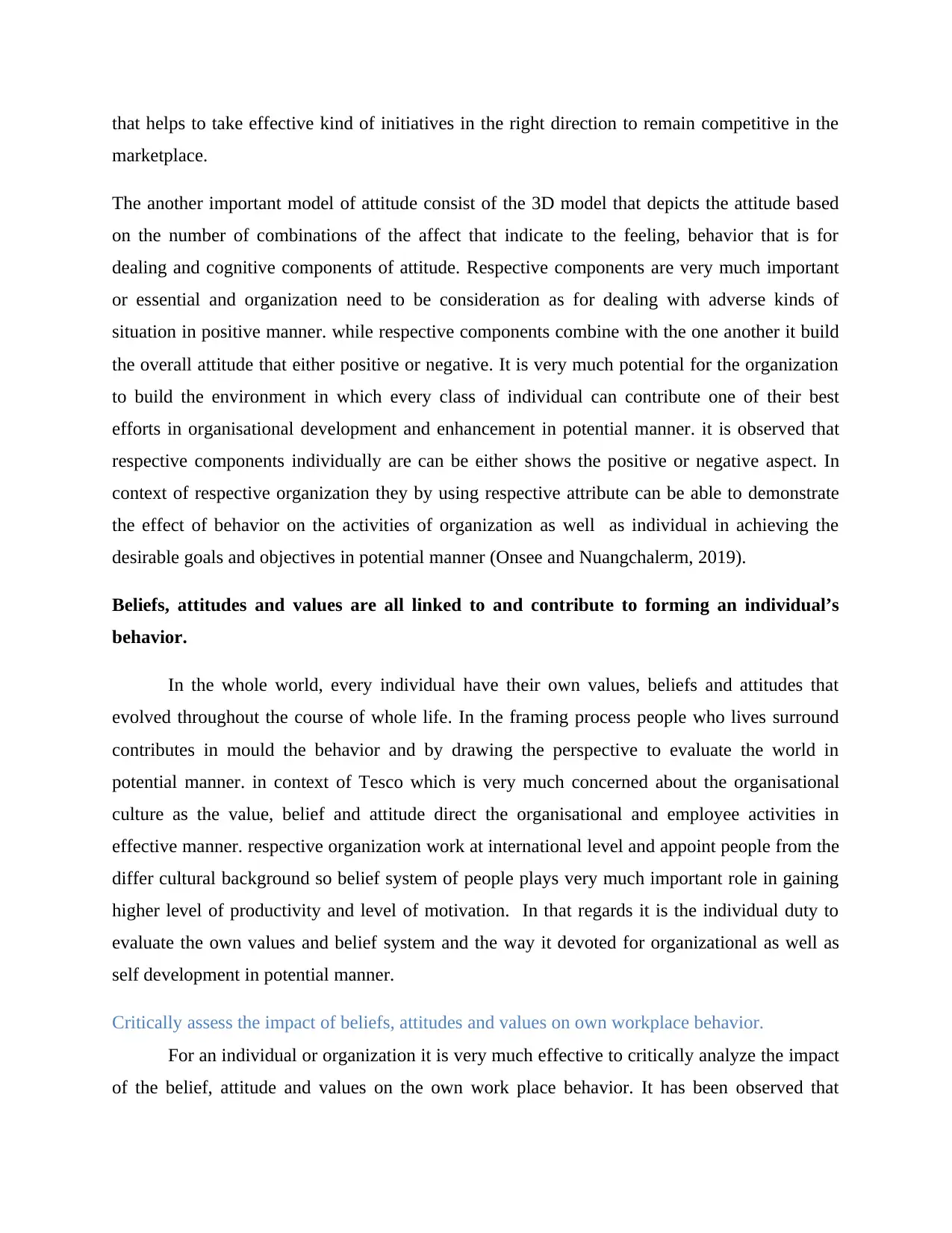
that helps to take effective kind of initiatives in the right direction to remain competitive in the
marketplace.
The another important model of attitude consist of the 3D model that depicts the attitude based
on the number of combinations of the affect that indicate to the feeling, behavior that is for
dealing and cognitive components of attitude. Respective components are very much important
or essential and organization need to be consideration as for dealing with adverse kinds of
situation in positive manner. while respective components combine with the one another it build
the overall attitude that either positive or negative. It is very much potential for the organization
to build the environment in which every class of individual can contribute one of their best
efforts in organisational development and enhancement in potential manner. it is observed that
respective components individually are can be either shows the positive or negative aspect. In
context of respective organization they by using respective attribute can be able to demonstrate
the effect of behavior on the activities of organization as well as individual in achieving the
desirable goals and objectives in potential manner (Onsee and Nuangchalerm, 2019).
Beliefs, attitudes and values are all linked to and contribute to forming an individual’s
behavior.
In the whole world, every individual have their own values, beliefs and attitudes that
evolved throughout the course of whole life. In the framing process people who lives surround
contributes in mould the behavior and by drawing the perspective to evaluate the world in
potential manner. in context of Tesco which is very much concerned about the organisational
culture as the value, belief and attitude direct the organisational and employee activities in
effective manner. respective organization work at international level and appoint people from the
differ cultural background so belief system of people plays very much important role in gaining
higher level of productivity and level of motivation. In that regards it is the individual duty to
evaluate the own values and belief system and the way it devoted for organizational as well as
self development in potential manner.
Critically assess the impact of beliefs, attitudes and values on own workplace behavior.
For an individual or organization it is very much effective to critically analyze the impact
of the belief, attitude and values on the own work place behavior. It has been observed that
marketplace.
The another important model of attitude consist of the 3D model that depicts the attitude based
on the number of combinations of the affect that indicate to the feeling, behavior that is for
dealing and cognitive components of attitude. Respective components are very much important
or essential and organization need to be consideration as for dealing with adverse kinds of
situation in positive manner. while respective components combine with the one another it build
the overall attitude that either positive or negative. It is very much potential for the organization
to build the environment in which every class of individual can contribute one of their best
efforts in organisational development and enhancement in potential manner. it is observed that
respective components individually are can be either shows the positive or negative aspect. In
context of respective organization they by using respective attribute can be able to demonstrate
the effect of behavior on the activities of organization as well as individual in achieving the
desirable goals and objectives in potential manner (Onsee and Nuangchalerm, 2019).
Beliefs, attitudes and values are all linked to and contribute to forming an individual’s
behavior.
In the whole world, every individual have their own values, beliefs and attitudes that
evolved throughout the course of whole life. In the framing process people who lives surround
contributes in mould the behavior and by drawing the perspective to evaluate the world in
potential manner. in context of Tesco which is very much concerned about the organisational
culture as the value, belief and attitude direct the organisational and employee activities in
effective manner. respective organization work at international level and appoint people from the
differ cultural background so belief system of people plays very much important role in gaining
higher level of productivity and level of motivation. In that regards it is the individual duty to
evaluate the own values and belief system and the way it devoted for organizational as well as
self development in potential manner.
Critically assess the impact of beliefs, attitudes and values on own workplace behavior.
For an individual or organization it is very much effective to critically analyze the impact
of the belief, attitude and values on the own work place behavior. It has been observed that
⊘ This is a preview!⊘
Do you want full access?
Subscribe today to unlock all pages.

Trusted by 1+ million students worldwide
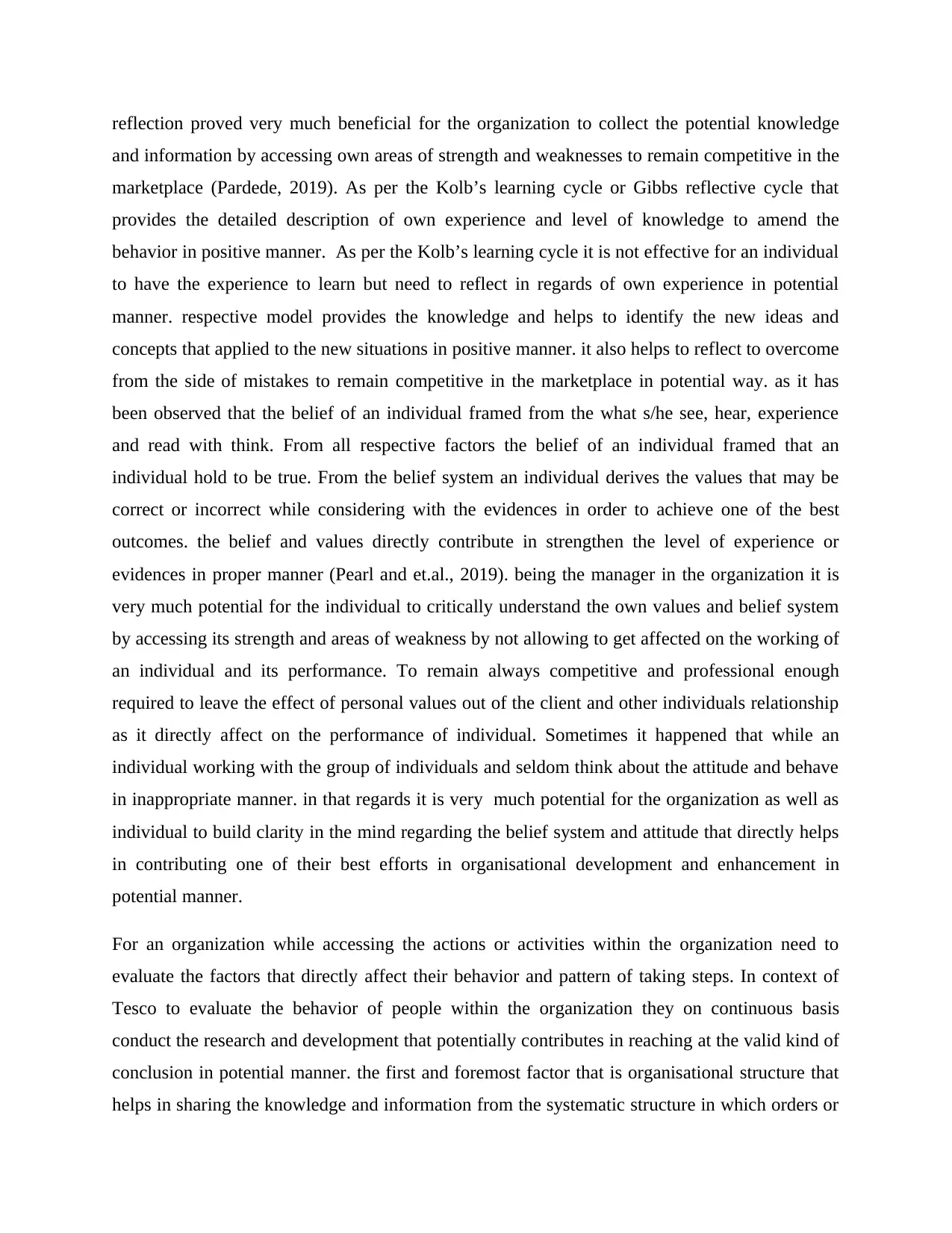
reflection proved very much beneficial for the organization to collect the potential knowledge
and information by accessing own areas of strength and weaknesses to remain competitive in the
marketplace (Pardede, 2019). As per the Kolb’s learning cycle or Gibbs reflective cycle that
provides the detailed description of own experience and level of knowledge to amend the
behavior in positive manner. As per the Kolb’s learning cycle it is not effective for an individual
to have the experience to learn but need to reflect in regards of own experience in potential
manner. respective model provides the knowledge and helps to identify the new ideas and
concepts that applied to the new situations in positive manner. it also helps to reflect to overcome
from the side of mistakes to remain competitive in the marketplace in potential way. as it has
been observed that the belief of an individual framed from the what s/he see, hear, experience
and read with think. From all respective factors the belief of an individual framed that an
individual hold to be true. From the belief system an individual derives the values that may be
correct or incorrect while considering with the evidences in order to achieve one of the best
outcomes. the belief and values directly contribute in strengthen the level of experience or
evidences in proper manner (Pearl and et.al., 2019). being the manager in the organization it is
very much potential for the individual to critically understand the own values and belief system
by accessing its strength and areas of weakness by not allowing to get affected on the working of
an individual and its performance. To remain always competitive and professional enough
required to leave the effect of personal values out of the client and other individuals relationship
as it directly affect on the performance of individual. Sometimes it happened that while an
individual working with the group of individuals and seldom think about the attitude and behave
in inappropriate manner. in that regards it is very much potential for the organization as well as
individual to build clarity in the mind regarding the belief system and attitude that directly helps
in contributing one of their best efforts in organisational development and enhancement in
potential manner.
For an organization while accessing the actions or activities within the organization need to
evaluate the factors that directly affect their behavior and pattern of taking steps. In context of
Tesco to evaluate the behavior of people within the organization they on continuous basis
conduct the research and development that potentially contributes in reaching at the valid kind of
conclusion in potential manner. the first and foremost factor that is organisational structure that
helps in sharing the knowledge and information from the systematic structure in which orders or
and information by accessing own areas of strength and weaknesses to remain competitive in the
marketplace (Pardede, 2019). As per the Kolb’s learning cycle or Gibbs reflective cycle that
provides the detailed description of own experience and level of knowledge to amend the
behavior in positive manner. As per the Kolb’s learning cycle it is not effective for an individual
to have the experience to learn but need to reflect in regards of own experience in potential
manner. respective model provides the knowledge and helps to identify the new ideas and
concepts that applied to the new situations in positive manner. it also helps to reflect to overcome
from the side of mistakes to remain competitive in the marketplace in potential way. as it has
been observed that the belief of an individual framed from the what s/he see, hear, experience
and read with think. From all respective factors the belief of an individual framed that an
individual hold to be true. From the belief system an individual derives the values that may be
correct or incorrect while considering with the evidences in order to achieve one of the best
outcomes. the belief and values directly contribute in strengthen the level of experience or
evidences in proper manner (Pearl and et.al., 2019). being the manager in the organization it is
very much potential for the individual to critically understand the own values and belief system
by accessing its strength and areas of weakness by not allowing to get affected on the working of
an individual and its performance. To remain always competitive and professional enough
required to leave the effect of personal values out of the client and other individuals relationship
as it directly affect on the performance of individual. Sometimes it happened that while an
individual working with the group of individuals and seldom think about the attitude and behave
in inappropriate manner. in that regards it is very much potential for the organization as well as
individual to build clarity in the mind regarding the belief system and attitude that directly helps
in contributing one of their best efforts in organisational development and enhancement in
potential manner.
For an organization while accessing the actions or activities within the organization need to
evaluate the factors that directly affect their behavior and pattern of taking steps. In context of
Tesco to evaluate the behavior of people within the organization they on continuous basis
conduct the research and development that potentially contributes in reaching at the valid kind of
conclusion in potential manner. the first and foremost factor that is organisational structure that
helps in sharing the knowledge and information from the systematic structure in which orders or
Paraphrase This Document
Need a fresh take? Get an instant paraphrase of this document with our AI Paraphraser
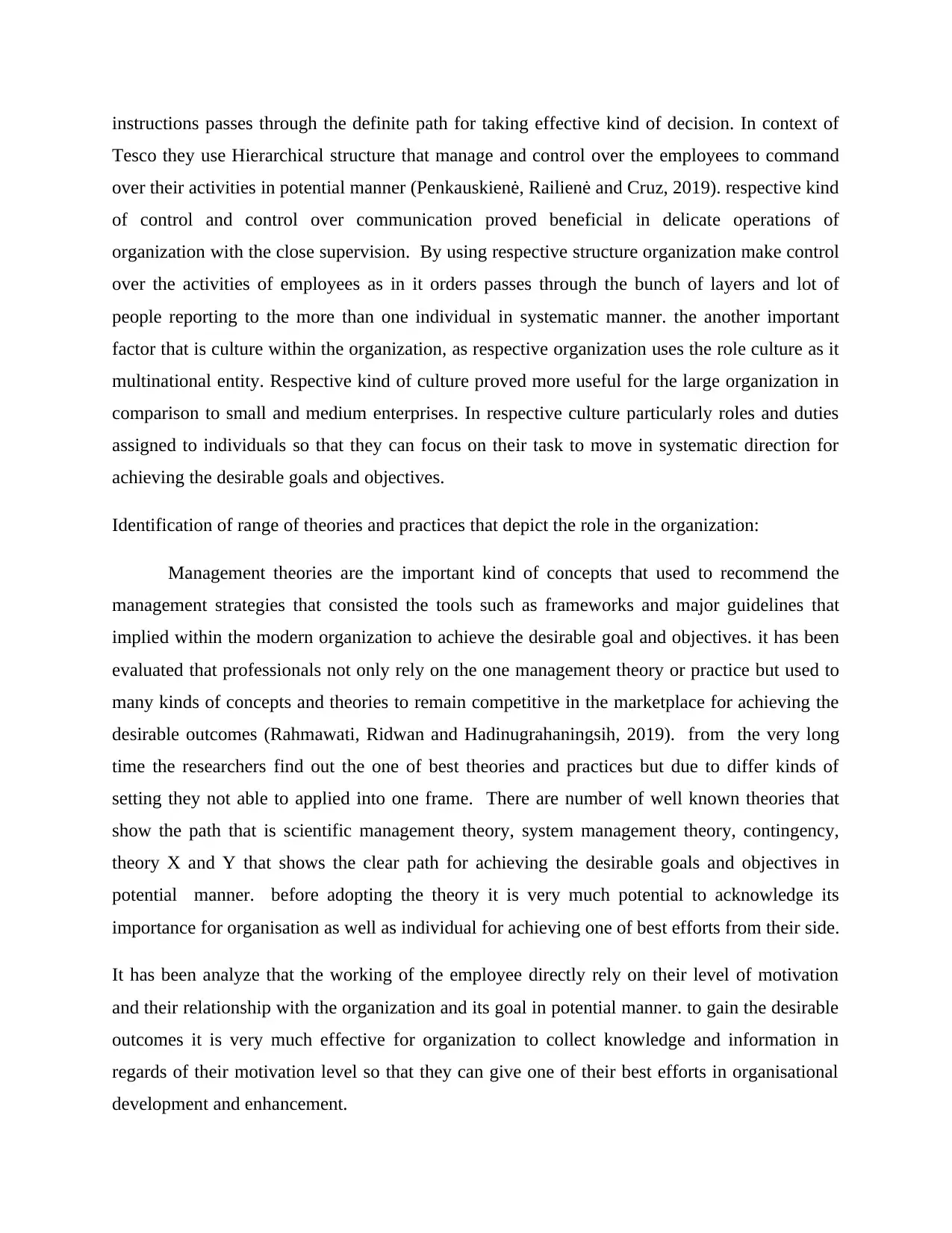
instructions passes through the definite path for taking effective kind of decision. In context of
Tesco they use Hierarchical structure that manage and control over the employees to command
over their activities in potential manner (Penkauskienė, Railienė and Cruz, 2019). respective kind
of control and control over communication proved beneficial in delicate operations of
organization with the close supervision. By using respective structure organization make control
over the activities of employees as in it orders passes through the bunch of layers and lot of
people reporting to the more than one individual in systematic manner. the another important
factor that is culture within the organization, as respective organization uses the role culture as it
multinational entity. Respective kind of culture proved more useful for the large organization in
comparison to small and medium enterprises. In respective culture particularly roles and duties
assigned to individuals so that they can focus on their task to move in systematic direction for
achieving the desirable goals and objectives.
Identification of range of theories and practices that depict the role in the organization:
Management theories are the important kind of concepts that used to recommend the
management strategies that consisted the tools such as frameworks and major guidelines that
implied within the modern organization to achieve the desirable goal and objectives. it has been
evaluated that professionals not only rely on the one management theory or practice but used to
many kinds of concepts and theories to remain competitive in the marketplace for achieving the
desirable outcomes (Rahmawati, Ridwan and Hadinugrahaningsih, 2019). from the very long
time the researchers find out the one of best theories and practices but due to differ kinds of
setting they not able to applied into one frame. There are number of well known theories that
show the path that is scientific management theory, system management theory, contingency,
theory X and Y that shows the clear path for achieving the desirable goals and objectives in
potential manner. before adopting the theory it is very much potential to acknowledge its
importance for organisation as well as individual for achieving one of best efforts from their side.
It has been analyze that the working of the employee directly rely on their level of motivation
and their relationship with the organization and its goal in potential manner. to gain the desirable
outcomes it is very much effective for organization to collect knowledge and information in
regards of their motivation level so that they can give one of their best efforts in organisational
development and enhancement.
Tesco they use Hierarchical structure that manage and control over the employees to command
over their activities in potential manner (Penkauskienė, Railienė and Cruz, 2019). respective kind
of control and control over communication proved beneficial in delicate operations of
organization with the close supervision. By using respective structure organization make control
over the activities of employees as in it orders passes through the bunch of layers and lot of
people reporting to the more than one individual in systematic manner. the another important
factor that is culture within the organization, as respective organization uses the role culture as it
multinational entity. Respective kind of culture proved more useful for the large organization in
comparison to small and medium enterprises. In respective culture particularly roles and duties
assigned to individuals so that they can focus on their task to move in systematic direction for
achieving the desirable goals and objectives.
Identification of range of theories and practices that depict the role in the organization:
Management theories are the important kind of concepts that used to recommend the
management strategies that consisted the tools such as frameworks and major guidelines that
implied within the modern organization to achieve the desirable goal and objectives. it has been
evaluated that professionals not only rely on the one management theory or practice but used to
many kinds of concepts and theories to remain competitive in the marketplace for achieving the
desirable outcomes (Rahmawati, Ridwan and Hadinugrahaningsih, 2019). from the very long
time the researchers find out the one of best theories and practices but due to differ kinds of
setting they not able to applied into one frame. There are number of well known theories that
show the path that is scientific management theory, system management theory, contingency,
theory X and Y that shows the clear path for achieving the desirable goals and objectives in
potential manner. before adopting the theory it is very much potential to acknowledge its
importance for organisation as well as individual for achieving one of best efforts from their side.
It has been analyze that the working of the employee directly rely on their level of motivation
and their relationship with the organization and its goal in potential manner. to gain the desirable
outcomes it is very much effective for organization to collect knowledge and information in
regards of their motivation level so that they can give one of their best efforts in organisational
development and enhancement.
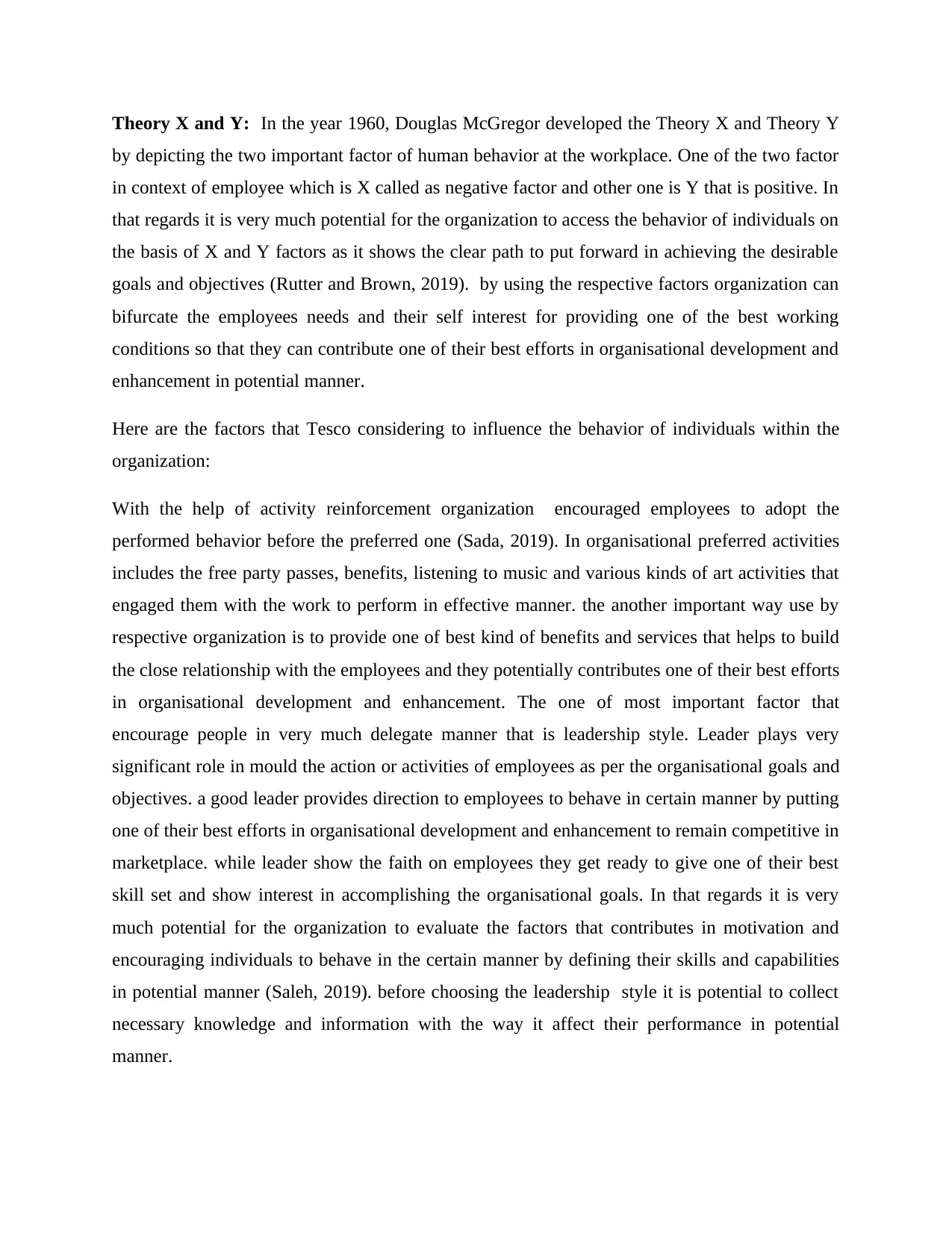
Theory X and Y: In the year 1960, Douglas McGregor developed the Theory X and Theory Y
by depicting the two important factor of human behavior at the workplace. One of the two factor
in context of employee which is X called as negative factor and other one is Y that is positive. In
that regards it is very much potential for the organization to access the behavior of individuals on
the basis of X and Y factors as it shows the clear path to put forward in achieving the desirable
goals and objectives (Rutter and Brown, 2019). by using the respective factors organization can
bifurcate the employees needs and their self interest for providing one of the best working
conditions so that they can contribute one of their best efforts in organisational development and
enhancement in potential manner.
Here are the factors that Tesco considering to influence the behavior of individuals within the
organization:
With the help of activity reinforcement organization encouraged employees to adopt the
performed behavior before the preferred one (Sada, 2019). In organisational preferred activities
includes the free party passes, benefits, listening to music and various kinds of art activities that
engaged them with the work to perform in effective manner. the another important way use by
respective organization is to provide one of best kind of benefits and services that helps to build
the close relationship with the employees and they potentially contributes one of their best efforts
in organisational development and enhancement. The one of most important factor that
encourage people in very much delegate manner that is leadership style. Leader plays very
significant role in mould the action or activities of employees as per the organisational goals and
objectives. a good leader provides direction to employees to behave in certain manner by putting
one of their best efforts in organisational development and enhancement to remain competitive in
marketplace. while leader show the faith on employees they get ready to give one of their best
skill set and show interest in accomplishing the organisational goals. In that regards it is very
much potential for the organization to evaluate the factors that contributes in motivation and
encouraging individuals to behave in the certain manner by defining their skills and capabilities
in potential manner (Saleh, 2019). before choosing the leadership style it is potential to collect
necessary knowledge and information with the way it affect their performance in potential
manner.
by depicting the two important factor of human behavior at the workplace. One of the two factor
in context of employee which is X called as negative factor and other one is Y that is positive. In
that regards it is very much potential for the organization to access the behavior of individuals on
the basis of X and Y factors as it shows the clear path to put forward in achieving the desirable
goals and objectives (Rutter and Brown, 2019). by using the respective factors organization can
bifurcate the employees needs and their self interest for providing one of the best working
conditions so that they can contribute one of their best efforts in organisational development and
enhancement in potential manner.
Here are the factors that Tesco considering to influence the behavior of individuals within the
organization:
With the help of activity reinforcement organization encouraged employees to adopt the
performed behavior before the preferred one (Sada, 2019). In organisational preferred activities
includes the free party passes, benefits, listening to music and various kinds of art activities that
engaged them with the work to perform in effective manner. the another important way use by
respective organization is to provide one of best kind of benefits and services that helps to build
the close relationship with the employees and they potentially contributes one of their best efforts
in organisational development and enhancement. The one of most important factor that
encourage people in very much delegate manner that is leadership style. Leader plays very
significant role in mould the action or activities of employees as per the organisational goals and
objectives. a good leader provides direction to employees to behave in certain manner by putting
one of their best efforts in organisational development and enhancement to remain competitive in
marketplace. while leader show the faith on employees they get ready to give one of their best
skill set and show interest in accomplishing the organisational goals. In that regards it is very
much potential for the organization to evaluate the factors that contributes in motivation and
encouraging individuals to behave in the certain manner by defining their skills and capabilities
in potential manner (Saleh, 2019). before choosing the leadership style it is potential to collect
necessary knowledge and information with the way it affect their performance in potential
manner.
⊘ This is a preview!⊘
Do you want full access?
Subscribe today to unlock all pages.

Trusted by 1+ million students worldwide

Evidence of wide reading and research, encompassing application of relevant academic theories
and models.
There are different numbers of theories and models that will be beneficial in context of
beliefs, attitudes and value systems within Tesco. Some important and effective theories and
models will be explained as below apart from their applications to the Tesco in relation to
beliefs, attitudes and value systems. These are:
Scientific management: It introduces as a theory of management that evaluate and
synthesizes workflows. Main objective of this theory is to enhance economic efficiency, mainly
labor productivity. F. W. Taylor’s Scientific Management Theory in Modern Day Workplace is
important for an organization because it will helps company in management of each situation in
essentially and effectively. Frederick Winslow Taylor (1856-1915) is known as the father of
Scientific Management (Waring, 2016). His enjoy from the lowest-maximum stage within the
organization gave him and possibility to recognize in the beginning the problems of the
employees. Taylor’s essential difficulty became that of increasing efficiency in production, no
longer simplest to decrease prices and raise profits however also to make feasible improved pay
for workers via their better productivity. This theory has four principles that will be beneficial
and essential for Tesco in improvement of behavior and attitudes among employees. These
principles will be explained as below:
Replace working through “rule of thumb,” or easy addiction and not unusual feel, and
instead use the medical technique to observe work and determine the maximum green
manner to perform specific obligations.
Rather than genuinely assign workers to simply any process, fit employees to their jobs
primarily based on functionality and motivation, and educate them to paintings at
maximum efficiency.
Monitor employee overall performance, and offer commands and supervision to make
sure that they’re using the maximum efficient methods of running.
Allocate the work among managers and workers in order that the managers spend their
time planning and training, permitting the people to carry out their obligations
successfully.
and models.
There are different numbers of theories and models that will be beneficial in context of
beliefs, attitudes and value systems within Tesco. Some important and effective theories and
models will be explained as below apart from their applications to the Tesco in relation to
beliefs, attitudes and value systems. These are:
Scientific management: It introduces as a theory of management that evaluate and
synthesizes workflows. Main objective of this theory is to enhance economic efficiency, mainly
labor productivity. F. W. Taylor’s Scientific Management Theory in Modern Day Workplace is
important for an organization because it will helps company in management of each situation in
essentially and effectively. Frederick Winslow Taylor (1856-1915) is known as the father of
Scientific Management (Waring, 2016). His enjoy from the lowest-maximum stage within the
organization gave him and possibility to recognize in the beginning the problems of the
employees. Taylor’s essential difficulty became that of increasing efficiency in production, no
longer simplest to decrease prices and raise profits however also to make feasible improved pay
for workers via their better productivity. This theory has four principles that will be beneficial
and essential for Tesco in improvement of behavior and attitudes among employees. These
principles will be explained as below:
Replace working through “rule of thumb,” or easy addiction and not unusual feel, and
instead use the medical technique to observe work and determine the maximum green
manner to perform specific obligations.
Rather than genuinely assign workers to simply any process, fit employees to their jobs
primarily based on functionality and motivation, and educate them to paintings at
maximum efficiency.
Monitor employee overall performance, and offer commands and supervision to make
sure that they’re using the maximum efficient methods of running.
Allocate the work among managers and workers in order that the managers spend their
time planning and training, permitting the people to carry out their obligations
successfully.
Paraphrase This Document
Need a fresh take? Get an instant paraphrase of this document with our AI Paraphraser
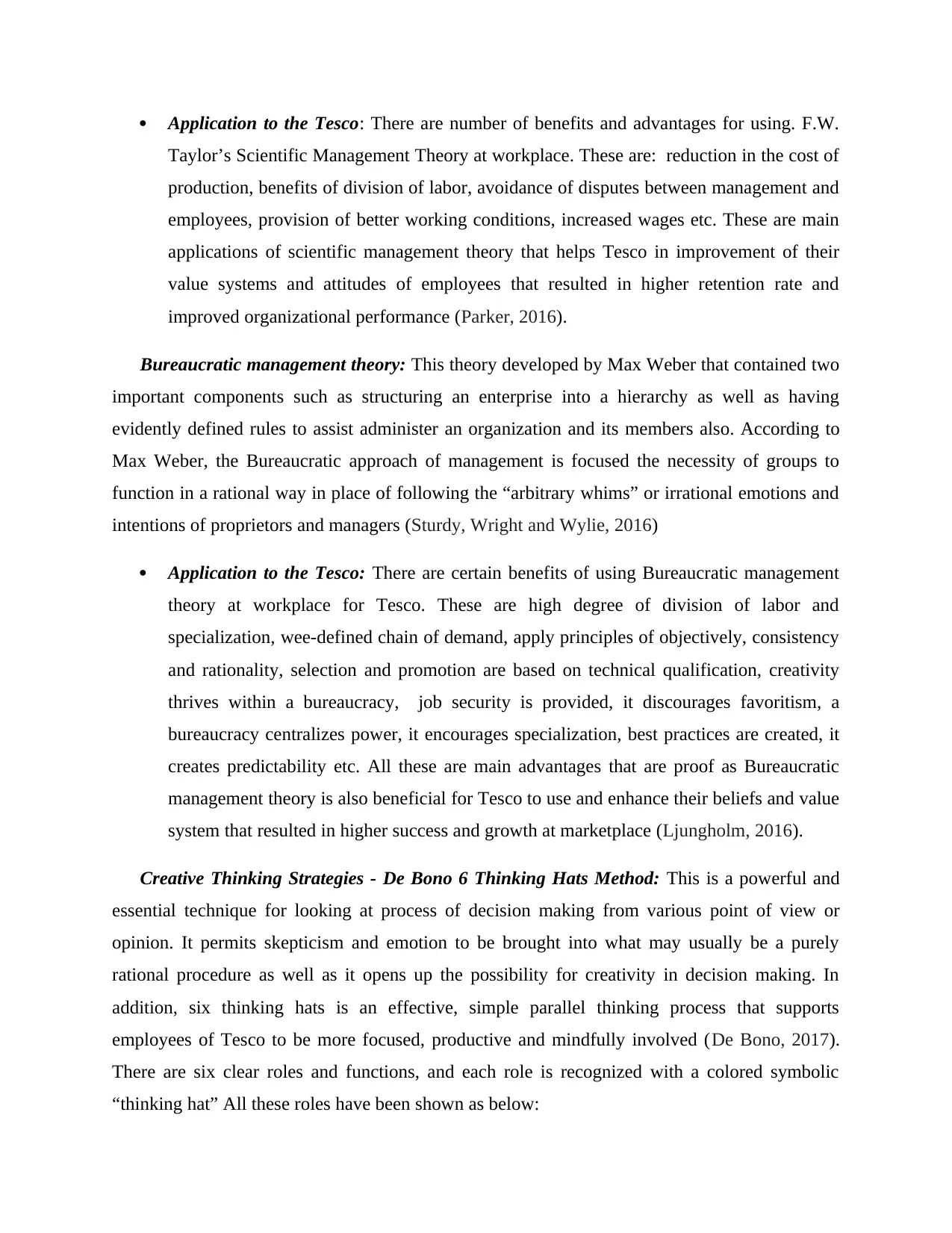
Application to the Tesco: There are number of benefits and advantages for using. F.W.
Taylor’s Scientific Management Theory at workplace. These are: reduction in the cost of
production, benefits of division of labor, avoidance of disputes between management and
employees, provision of better working conditions, increased wages etc. These are main
applications of scientific management theory that helps Tesco in improvement of their
value systems and attitudes of employees that resulted in higher retention rate and
improved organizational performance (Parker, 2016).
Bureaucratic management theory: This theory developed by Max Weber that contained two
important components such as structuring an enterprise into a hierarchy as well as having
evidently defined rules to assist administer an organization and its members also. According to
Max Weber, the Bureaucratic approach of management is focused the necessity of groups to
function in a rational way in place of following the “arbitrary whims” or irrational emotions and
intentions of proprietors and managers (Sturdy, Wright and Wylie, 2016)
Application to the Tesco: There are certain benefits of using Bureaucratic management
theory at workplace for Tesco. These are high degree of division of labor and
specialization, wee-defined chain of demand, apply principles of objectively, consistency
and rationality, selection and promotion are based on technical qualification, creativity
thrives within a bureaucracy, job security is provided, it discourages favoritism, a
bureaucracy centralizes power, it encourages specialization, best practices are created, it
creates predictability etc. All these are main advantages that are proof as Bureaucratic
management theory is also beneficial for Tesco to use and enhance their beliefs and value
system that resulted in higher success and growth at marketplace (Ljungholm, 2016).
Creative Thinking Strategies - De Bono 6 Thinking Hats Method: This is a powerful and
essential technique for looking at process of decision making from various point of view or
opinion. It permits skepticism and emotion to be brought into what may usually be a purely
rational procedure as well as it opens up the possibility for creativity in decision making. In
addition, six thinking hats is an effective, simple parallel thinking process that supports
employees of Tesco to be more focused, productive and mindfully involved (De Bono, 2017).
There are six clear roles and functions, and each role is recognized with a colored symbolic
“thinking hat” All these roles have been shown as below:
Taylor’s Scientific Management Theory at workplace. These are: reduction in the cost of
production, benefits of division of labor, avoidance of disputes between management and
employees, provision of better working conditions, increased wages etc. These are main
applications of scientific management theory that helps Tesco in improvement of their
value systems and attitudes of employees that resulted in higher retention rate and
improved organizational performance (Parker, 2016).
Bureaucratic management theory: This theory developed by Max Weber that contained two
important components such as structuring an enterprise into a hierarchy as well as having
evidently defined rules to assist administer an organization and its members also. According to
Max Weber, the Bureaucratic approach of management is focused the necessity of groups to
function in a rational way in place of following the “arbitrary whims” or irrational emotions and
intentions of proprietors and managers (Sturdy, Wright and Wylie, 2016)
Application to the Tesco: There are certain benefits of using Bureaucratic management
theory at workplace for Tesco. These are high degree of division of labor and
specialization, wee-defined chain of demand, apply principles of objectively, consistency
and rationality, selection and promotion are based on technical qualification, creativity
thrives within a bureaucracy, job security is provided, it discourages favoritism, a
bureaucracy centralizes power, it encourages specialization, best practices are created, it
creates predictability etc. All these are main advantages that are proof as Bureaucratic
management theory is also beneficial for Tesco to use and enhance their beliefs and value
system that resulted in higher success and growth at marketplace (Ljungholm, 2016).
Creative Thinking Strategies - De Bono 6 Thinking Hats Method: This is a powerful and
essential technique for looking at process of decision making from various point of view or
opinion. It permits skepticism and emotion to be brought into what may usually be a purely
rational procedure as well as it opens up the possibility for creativity in decision making. In
addition, six thinking hats is an effective, simple parallel thinking process that supports
employees of Tesco to be more focused, productive and mindfully involved (De Bono, 2017).
There are six clear roles and functions, and each role is recognized with a colored symbolic
“thinking hat” All these roles have been shown as below:
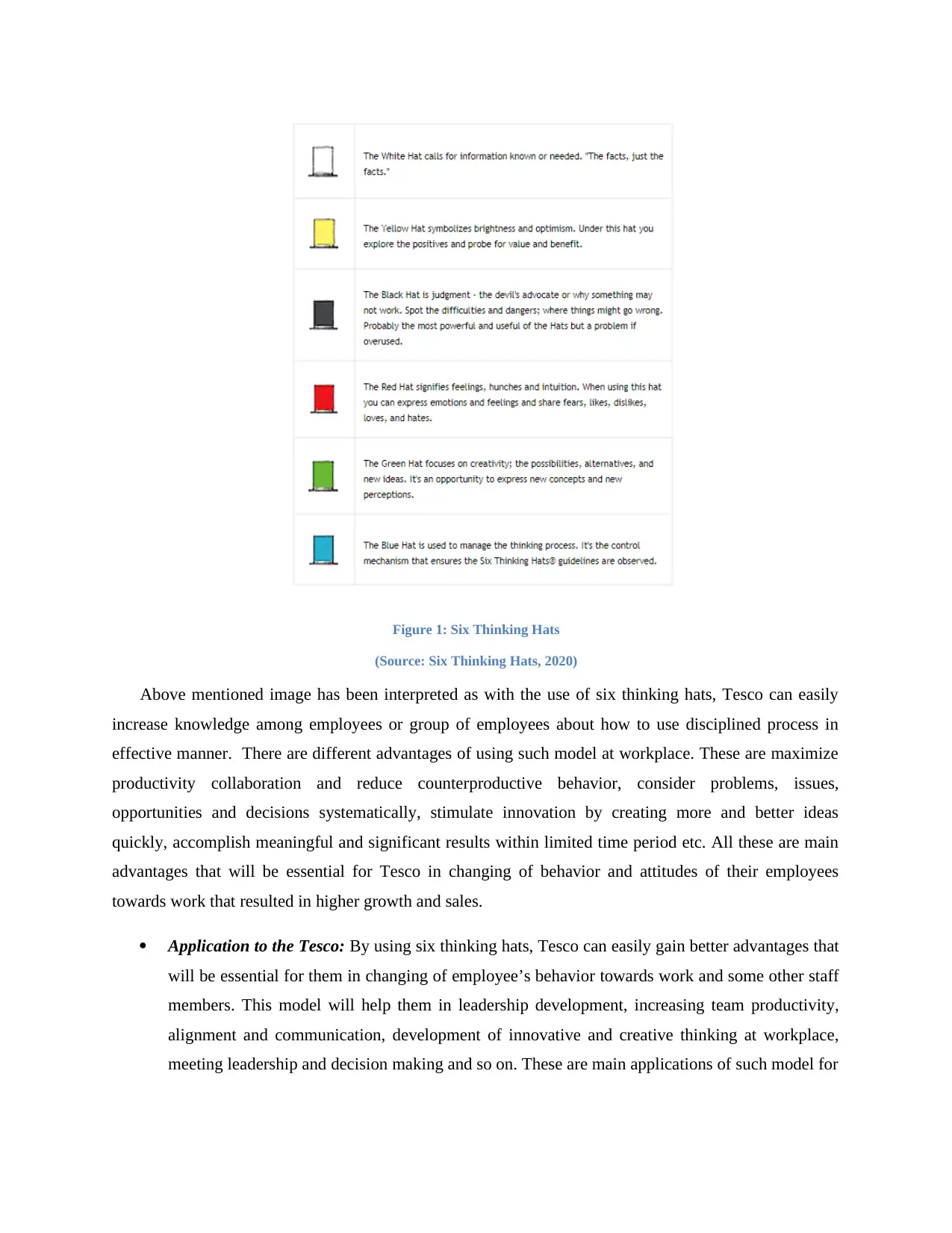
Figure 1: Six Thinking Hats
(Source: Six Thinking Hats, 2020)
Above mentioned image has been interpreted as with the use of six thinking hats, Tesco can easily
increase knowledge among employees or group of employees about how to use disciplined process in
effective manner. There are different advantages of using such model at workplace. These are maximize
productivity collaboration and reduce counterproductive behavior, consider problems, issues,
opportunities and decisions systematically, stimulate innovation by creating more and better ideas
quickly, accomplish meaningful and significant results within limited time period etc. All these are main
advantages that will be essential for Tesco in changing of behavior and attitudes of their employees
towards work that resulted in higher growth and sales.
Application to the Tesco: By using six thinking hats, Tesco can easily gain better advantages that
will be essential for them in changing of employee’s behavior towards work and some other staff
members. This model will help them in leadership development, increasing team productivity,
alignment and communication, development of innovative and creative thinking at workplace,
meeting leadership and decision making and so on. These are main applications of such model for
(Source: Six Thinking Hats, 2020)
Above mentioned image has been interpreted as with the use of six thinking hats, Tesco can easily
increase knowledge among employees or group of employees about how to use disciplined process in
effective manner. There are different advantages of using such model at workplace. These are maximize
productivity collaboration and reduce counterproductive behavior, consider problems, issues,
opportunities and decisions systematically, stimulate innovation by creating more and better ideas
quickly, accomplish meaningful and significant results within limited time period etc. All these are main
advantages that will be essential for Tesco in changing of behavior and attitudes of their employees
towards work that resulted in higher growth and sales.
Application to the Tesco: By using six thinking hats, Tesco can easily gain better advantages that
will be essential for them in changing of employee’s behavior towards work and some other staff
members. This model will help them in leadership development, increasing team productivity,
alignment and communication, development of innovative and creative thinking at workplace,
meeting leadership and decision making and so on. These are main applications of such model for
⊘ This is a preview!⊘
Do you want full access?
Subscribe today to unlock all pages.

Trusted by 1+ million students worldwide
1 out of 16